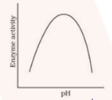NCERT Solutions for Chapter: Biomolecules, Exercise 3: SHORT ANSWER TYPE QUESTIONS
NCERT Biology Solutions for Exercise - NCERT Solutions for Chapter: Biomolecules, Exercise 3: SHORT ANSWER TYPE QUESTIONS
Attempt the practice questions on Chapter 9: Biomolecules, Exercise 3: SHORT ANSWER TYPE QUESTIONS with hints and solutions to strengthen your understanding. NCERT Exemplar Biology - Class 11 solutions are prepared by Experienced Embibe Experts.
Questions from NCERT Solutions for Chapter: Biomolecules, Exercise 3: SHORT ANSWER TYPE QUESTIONS with Hints & Solutions
Enzymes are proteins. Proteins are long chains of amino acids linked to each other by peptide bonds. Amino acids have many functional groups in their structure. These functional groups are, many of them at least, ionisable. As they are weak acids and bases in chemical nature, this ionization is influenced by pH of the solution. For many enzymes, activity is influenced by surrounding pH. This is depicted in the curve given, explain briefly.
Is rubber a primary metabolite or a secondary metabolite? Write four sentences about rubber.
Schematically represent primary, secondary and tertiary structures of a hypothetical polymer say for example a protein.
Nucleic acids exhibit secondary structure, justify with example.
Comment on the statement "living state is a non-equilibrium steady-state to be able to perform work".

